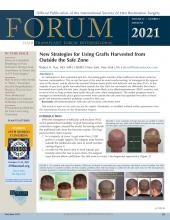Abstract
Introduction: Pain during administration of local anesthesia during donor strip surgery in follicular unit transplantation (FUT) can cause discomfort for the patient. Controlled breathing, as a component of various relaxation techniques, has been shown to have a beneficial effect in acute pain tolerance.
Objective: This study evaluates the relevance of controlled breathing as a technique to enhance pain tolerance throughout the administration of local anesthesia during donor strip excision in hair transplantation.
Methods: A prospective, comparative study was undertaken between two groups of 30 patients each undergoing hair transplantation by strip FUT technique under local anesthesia (LA). One group was trained to use controlled breathing prior to surgery and during administration of local anesthesia at the donor site. The other group used routine breathing and was used as the control. Pain tolerance was measured subjectively using Visual Analog Score (VAS) for pain and objectively using the Objective Pain Comfort Score (OPCS). In addition, pulse and blood pressure were monitored. The results were compared and analyzed statistically.
Results: The mean changes of VAS and OPC pain scores and vital parameters, such as pulse, in response to acute pain were significantly reduced in the test group, which used controlled and relaxed breathing, compared to the control group. However, there was no significant difference in blood pressure measurements between the two groups.
Conclusion: Our study suggests that controlled breathing prior to hair transplantation and during LA injection at the donor site results in better pain perception and tolerance and, therefore, greater patient comfort. Patients can easily be taught to practice controlled breathing. Additional studies using larger groups of patients are needed to establish the routine role of this modality in pain management during hair transplantation.
- Copyright © 2021 by the International Society of Hair Restoration Surgery
This article requires a subscription to view the full text. If you have a subscription you may use the login form below to view the article.






